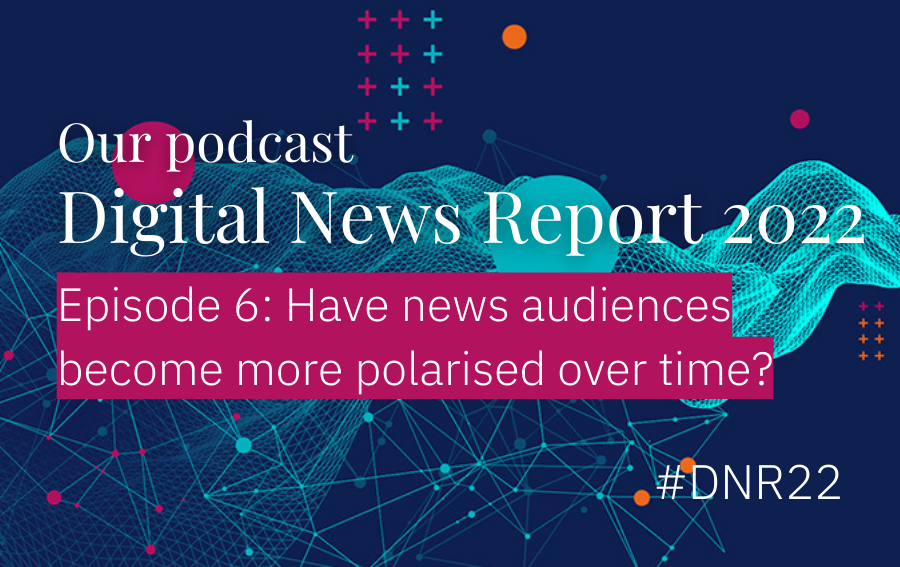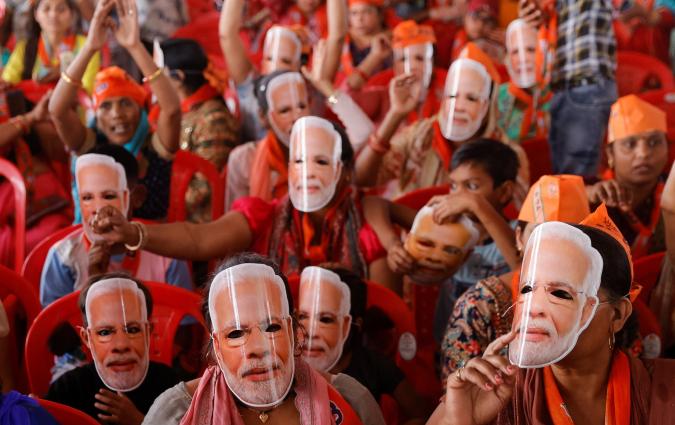Our podcast: Digital News Report 2022. Episode 6: Have news audiences become more polarised over time?

The topic
In this episode of the series we'll discuss findings from a Digital News Report chapter focusing on polarisation in news. We’ll look at whether news audiences really are as polarised as some may think, whether there has been any change since 2016, and how people perceive polarisation in their countries’ news environments.
The speakers
Richard Fletcher is Director of Research at the Reuters Institute. He is primarily interested in global trends in digital news consumption, comparative media research, the use of social media by journalists and news organisations, and more broadly, the relationship between technology and journalism.
Our host Federica Cherubini is Head of Leadership Development at the Reuters Institute. She is an expert in newsroom operations and organisational change, with more than ten years of experience spanning major publishers, research institutes and editorial networks around the world.
The podcast
Listen on: Spotify | Apple | Google
The transcript
What news audience polarisation means | Changes in media polarisation since 2016 | Current levels of new audience polarisation | Why news audience polarisation is fairly low | The digital news environment and polarisation | Perceptions of polarisation in news | Explaining narratives of division versus reality
What news audience polarisation means ↑
Federica: So your chapter in the report sets out to determine the level of polarisation among news audiences in four countries. First, though, can you explain the term polarisation? What does it mean, especially in regards to news audiences and how you can measure it?
Richard: Well, normally, when people use the term polarisation, they're usually referring to the extent of the differences in attitudes or beliefs between different people or different groups. Or sometimes how do people feel about those in different groups. But here, we're interested in something slightly different. So we're interested in news audience behavior, the tendency for people to use certain news outlets and not to use others. In the UK, for example, we know that an outlet like the BBC has quite mixed audiences. But also, we know that people on the left are more likely to use outlets like the Guardian, and people on the right are more likely to use news outlets like the Mail. So what we're interested in is measuring the extent to which people behave like this, and then to compare it across countries. And we do this by looking at the online and offline audiences, for the main news outlets in each country, and then seeing how different they are from the population as a whole. So if a country has lots of outlets with strongly left-leaning audiences, and strongly right-leaning audiences, then we can think of it as having a relatively high degree of news audience polarisation. However, if outlets have mainly mixed or centrist audiences then the degree of news audience polarisation, is relatively low.
Federica: And you chose, as we mentioned, four countries: Norway, Germany, the UK and the US. Can you tell us why you chose these countries specifically?
Richard: I think the main reason was that we expected to be able to observe differences between those countries. So they each represent different types of media systems, which means, for example, they have different levels of funding for public service media, different levels of journalistic professionalism, and also different levels of political parallelism. So that's the extent to which news outlets reflect the views of certain political parties or political groups, especially historically. And we know that also, just more broadly, that countries like the UK and the US are usually thought of as more politically polarised than Norway and Germany.
Changes in media polarisation ↑
Federica: The Digital News Report team first started measuring polarisation in 2016. Since then, there have been a series of divisive ballots including elections involving Donald Trump and Boris Johnson, as well as the UK Brexit referendum. The media, of course, play a key role in covering these and perhaps influencing people's decision around how to vote. Gut instinct might say that polarisation has increased since 2016. Is this true? Has there been a shift?
Richard: Well, at least when it comes to news audience polarisation, and at least from our data, the answer is no, news audience polarisation doesn't seem to have changed much since 2016. So in other words, the extent to which people gravitate towards certain news outlets based on their political beliefs doesn't seem to have changed in each of these four countries. But at the same time, of course, that doesn't mean that other types of polarisation such as the ones I mentioned earlier, have stayed the same as well. So ideological polarisation amongst the public may have shifted and elite political discourse may have also become more polarised than it was. And of course, that's particularly important because that might also mean that the political positions represented by major news outlets in their coverage may have drifted further apart, ideologically. But as I said, we're focused here on news audience behaviour. And at least this it seems to hasn't changed since 2016. So people are still navigating the news environment in the same way, even though that environment may have changed.
Current levels of news audience polarisation ↑
Federica: Coming to the actual results of what you found in the survey. What differences do you find between countries? And you know, can you tell us which of the four shows the most polarisation amongst news audiences?
Richard: Well, the US has the highest level of news audience polarisation. And this is because it has a lot of outlets, firstly, with left-leaning audiences, and also a handful of outlets with strongly right leaning audiences, and relatively few outlets with mixed or centrist audiences. So there's lots of outlets with strongly skewed audiences. The UK has the second highest level of news audience polarisation. And in some ways, it's similar to the US. But the main difference is that it has some outlets such as the BBC and other large TV brands that attract audiences from both sides of the political spectrum, and also those who self identify as being in the centre. And this ultimately lowers the level of news audience polarisation that we see as a whole across the UK. In Germany and Norway, there are fewer outlets with skewed audiences, if compared to the US and UK, with most attracting mixed or centrist audiences. And those that attract slightly skewed audiences tend to be niche politically-focused outlets that have small audiences. So they have a relatively small effect on the overall picture. I think the other thing to point out is that even in a country like the US and to a certain extent, the UK, the kind of overall level of news audience polarisation that we see is is fairly low. And what I mean by that is that it's quite far away from what we might think of as the theoretical maximum level of polarisation. So even though we do see differences across countries, none of them I would say, are massively polarised in terms of news audience behaviour.
Why news audience polarisation is fairly low ↑
Federica: Can you tell us a bit more about what it is about the news environment makes the polarisation fairly low? What are the reasons for low polarisation?
Richard: Well, as I mentioned, having having large outlets in particular that have mixed or centrist audiences tends to help. And at least in parts of western and northern Europe, public service media tends to provide this. But also, in many cases, large commercial TV outlets, and also large newspaper brands can as well, of course. The audience is often a response to the content. And this matters a lot. So if outlets produce coverage that is less tied to a particular political position than we might expect it to attract a more mixed audience for that reason. It's also worth pointing out that in a country like Germany, the proportion who self-identified with the political right or the political left in the first place is a bit lower than in a country, like the UK, for example. And ultimately, this can have an effect on the kind of the level of news audience polarisation. That's possible. But I want to reiterate that it's really primarily influenced by behaviour and not this fact.
The digital news environment and polarisation ↑
Federica: You mentioned that since 2016, there has been not a massive net change in terms of the level of polarisation of news audiences. And this is despite significant changes in online news use overall. And in the online news environment, I’m thinking smartphone usage, the rise of social media and aggregators as gateways to news paywalls and digital-first news brands, we've seen a lot of change, yet this measure of polarisation of news audiences doesn't seem to have changed that much. What do you think this is down to?
Richard: Well, I do think that changes in news audience polarisation are possible. But it's primarily influenced by the outlets that people choose to use. And despite some of the changes that you've described, people tend to use the same big newspaper and TV outlets that they always have. Even if we look at online news use, other data from the Digital News Report shows that in most cases, the list of the most widely used brands tends to say pretty similar year-on-year, because people, again are going back to the same new sources that they always have. And I suspect that when it comes to polarisation, any changes we see will be in the long term. So thinking perhaps in terms of decades, rather than years, but the fact that we can see quite considerable differences between countries shows that if there are changes, and there are differences domestically, you should be able to detect them. It’s just that we haven't seen them since 2016.
Federica: Turning to changes amongst individual news outlets, has there been any significant change amongst the audiences of particular news outlets that you've analysed in the report, and is there any explanation for these?
Richard: We do see some changes at the level of individual outlets. So in some cases, outlets perhaps have a more mixed or centrist audience than they had in 2016. Others have become more skewed towards the left or the right. And I think it's difficult to know from our data, what's actually behind this, but there are some possible explanations. So if an outlet, for example, has a more centrist audience, that's perhaps because they're attracting more people via social media where people can be incidentally exposed to news and it's less time to their political preferences, what news they encounter. In other cases, you know, the introduction of a paywall will make a difference. And in others, it may simply because the outlet’s changed its editorial line, and therefore is appealing to different groups of people that perhaps it wasn't before. But, as I said, it's difficult to know this from our data alone, but we do see some changes for the audiences for individual outlets.
Perceptions of polarisation in news ↑
Federica: Outside from this focus on the chapter of the four specific countries, or you look at you also asked, in the general survey, to all 46 markets, about the perception of news media polarisation in their respective countries. Can you tell us exactly what did you ask them?
Richard: Well, we asked them how politically close together or far apart they think the major news outlets are in their country. Of course, if people say that they think outlets are politically far apart, this would indicate that people are perceiving a high degree of polarisation. And if people say they're close together, there's perhaps they're perceiving a lower degree of polarisation. And, as always, we do see a lot of differences across countries across regions, when we ask this, but on the whole, at least, with the data we have, it seems to map on reasonably well to what we see in terms of patterns of news audience behaviour. But again, this it's important to reiterate, this is people's perception. And there are also sort of important differences between what people perceive and what people what is actually happening. And we can identify that in some cases with this data.
Federica: What are the main takeaways from country to country, the variation from country to country?
Richard: As said, I think it mainly maps onto what we know from news audience polarisation. So countries, which tend to have a lower level of news audience polarisation tend to also have lower levels of perceived polarisation and vice versa.
Explaining narratives of division versus reality ↑
Federica: I think sometimes there is a sort of like a narrative, Maybe not really data informed, it seems, maybe your report, you often hear people saying ‘society’s more divided than ever’. And your chapter seems to be saying that news audiences are not as divided as ever. Why is this narrative at odds [with your findings]? What can you tell us more about this?
Richard: Well, I think it is something that you hear people say, and I think it's often because people are very much caught up in the present. And it may feel like society is more divided than ever, but at the same time, we can often think back over several decades and remember bitter political disputes from the past. And then perhaps, that helps us put in put into context what we're going through today. That being said, of course, there may be some aspects of polarisation that are becoming stronger over time in particular countries. So elite discourse may be becoming more polarised, people's attitudes may becoming more polarised as well. But what I think our research can do and you know, looking specifically at news audience polarisation is, I think, to help us understand the role of the media and in any changes that we see. And I think, as I mentioned earlier, that because we can see that overall, even in a country like the US, that the level of news audience polarisation is relatively low, that helps us think about the you know, the potential of the media in shaping some of these changes. And it helps us to, perhaps look past some of the more simplistic accounts of change that involve the media, which are often predicated on the idea that everyone is making highly political news media choices, and people are ending up in a highly-siloed information environment. And that's just not what we see in our data.
Federica: Richard, thank you so much for helping us understand a bit better this very complicated issue and joining the podcast today.






